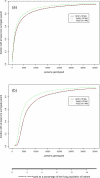Detection of sharing by descent, long-range phasing and haplotype imputation
- PMID: 19165921
- PMCID: PMC4540081
- DOI: 10.1038/ng.216
Detection of sharing by descent, long-range phasing and haplotype imputation
Abstract
Uncertainty about the phase of strings of SNPs creates complications in genetic analysis, although methods have been developed for phasing population-based samples. However, these methods can only phase a small number of SNPs effectively and become unreliable when applied to SNPs spanning many linkage disequilibrium (LD) blocks. Here we show how to phase more than 1,000 SNPs simultaneously for a large fraction of the 35,528 Icelanders genotyped by Illumina chips. Moreover, haplotypes that are identical by descent (IBD) between close and distant relatives, for example, those separated by ten meioses or more, can often be reliably detected. This method is particularly powerful in studies of the inheritance of recurrent mutations and fine-scale recombinations in large sample sets. A further extension of the method allows us to impute long haplotypes for individuals who are not genotyped.
Figures





References
MeSH terms
Substances
Grants and funding
LinkOut - more resources
Full Text Sources
Other Literature Sources
Research Materials

